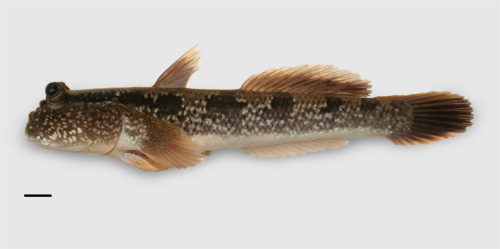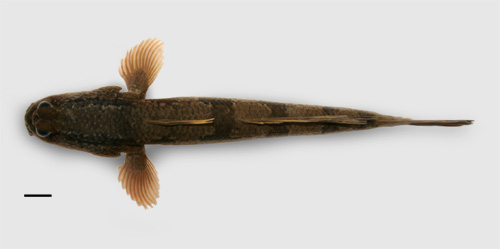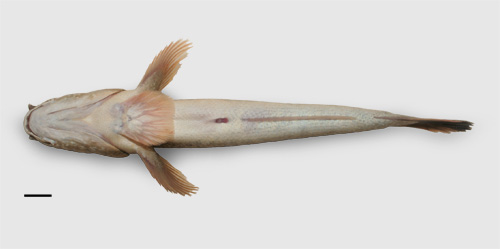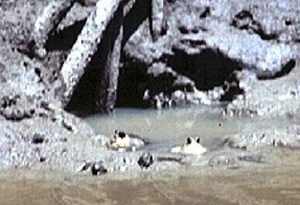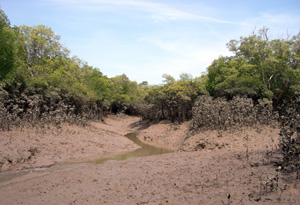Common names:
China |
Chinese Mandarin |
裸峡齿弹涂鱼, 裸峽齒彈塗魚 (luo xia chi tan tu yu - naked-isthmus teethed mudskipper) |
Philippines |
Tagalog |
bia |
Italy |
Italian |
perioftalmodonte di Freycinet* |
Papua New Guinea |
English |
pug-headed mudskipper |
* proposed name
|
|
|
Synonyms:
|
*In: Cuvier & Valenciennes, 1837 (authors do not cite Quoy & Gaimard, 1824: see online Catalog of Fishes)
Etymology:
'Periophthalmodon' is a compound form from 'Periophthalmus' and the Greek 'odous' (tooth), which refers to the prominent teeth
and strong similarity to the genus Periophthalmus
the species is named after Captain Freycinet, who collected the material for the original
description (Murdy, 1989)
|
Maximum recorded length:
210 mm SL (Murdy, 1989)
Live colouration (Murdy, 1989; Polgar et al., 2010; Takita et al., 2011; pers. obs.:
Australia NT):
ground colour pale brown with numerous white spots on flanks, venter white;
a dark brown dorsal stripe is often visible coursing from eye to caudal region; 5-6 saddle-like brown dorsal bars may be visible in smaller individuals (< 15-20 cm TL); D1 brown with white margin; D2 dusky brown with whitish margin; caudal
fin dark brown; anal fin hyaline; pectoral fins brownish to yellowish; pelvic fins white
Colouration on preservation (Murdy, 1989; pers. obs.: Australia NT, Philippines):
ground colour slate grey to brown dorsally and laterally, whitish ventrally; numerous whitish spots may be visible on cheeks
and snout; a dark brown dorsal stripe is often visible from eye to caudal region; saddle bars rarely retained; D1 and D2
brownish to blackish with whitish margin; caudal fin dark brown to blackish; anal fin and pelvic fins whitish to flesh coloured; pectoral fin brownish to
dusky
Diagnosis (Murdy, 1989):
D1 IV-V; pectoral fin rays 15-17; length of D1 base 5.0-8.1%SL; when visible, a narrow dark stripe courses dorsally from eye up to caudal peduncle;
isthmus lacking scales; snout scaled; dorsal fins not contiguous; pelvic fins completely fused and with pelvic frenum.
The genus is characterised by the presence of two rows of teeth on the upper jaw;
in this species the second row of teeth in the upper jaw contains few and smaller teeth, often half buried in the mucosa (pers. obs.)
Diet:
carnivorous; it mainly feeds on crabs (Milward, 1974), but can prey also on
other locally abundant animals, such as insects and syntopic species of mudskippers (e.g. Periophthalmus spp.: Milward, 1974; Nursall, 1981)
|
|
Reproduction:
no published study is available: only some notes on its burrowing behaviour by Nursall
(1981); its burrow is very similar to that one of
Periophthalmodon schlosseri;
as in this latter species, couples of individuals (probably a male and a female) have been observed to cohabit in the same burrow
(Takita et al., 2011)
middle:
two individuals cohabiting in the same burrow on a creek's bank (photo: J.R. Nursall, Queensland, Australia)
|
|
|
Ecological notes (Milward, 1974; Nursall, 1981; Polgar et al., 2010; Takita et al., 2011; pers. obs.: Australia NT):
it lives in habitats which are very similar to those of its putative sister species,
Pn. schlosseri (creek banks, bottoms of ephemeral tidal inlets, tidal mudflats); it seems to be a very
adaptable mudskipper, which is abundant also in areas impacted by human activities; as in
Pn. schlosseri, juveniles and young seem to be ecologically partitioned
from adults (Nursall, 1981; Takita et al., 2011), in forested areas and near shallow tide pools
middle: a tidal creek; burrows of Pn. freycineti were abundant on its mud banks (Sadgrove's Creek, Darwin, Northern Territory, Australia;
photo: G. Polgar, 2007)
|
|
|
|
Distribution (Murdy, 1989; Polgar et al., 2010):
Philippines, Eastern Indonesia, and northern Queensland, northern Australia; Papua New Guinea; type locality: Timor, Indonesia
|
Remarks:
as in Periophthalmodon schlosseri,
juveniles and young seem to retain the banded colouration pattern
|
Photographs of Periophthalmodon freycineti:
|
A: Pn. freycineti in its pool, the main opening of its burrow (photo:
Mike Edwardes, Australia, 2003); B: a burrow with the typical fresh tracks on the mud (photo: G. Polgar; Sadgrove's Creek, Darwin, NT, Australia, 2007); C:
an individual resting on a root at high tide (photo: G. Polgar; Sadgrove's Creek, Darwin, NT, Australia, 2007); D: another burrow of Pn. schlosseri (photo: G. Polgar; Sisikura Is., Fly river delta, Papua New Guinea, 2007); E, F:
individuals resting on the edge of their pool (photo: J.R. Nursall, Queensland, Australia); G: a close-up inside an aquarium (photo: G. Polgar; specimen collected in Purutu Is., Fly river delta, Papua New Guinea, 2007); H:
digging behaviour (photo: anonymous, Cairns, Queensland, Australia, 2006); I: another shot of the same individual of photo G (photo: G. Polgar, 2007); J: a burrow dug on the creek's bank: note how the mud gobbets are thrown always on the same side of the opening (photo: G. Polgar; Sadgrove's Creek, Darwin, NT, Australia, 2007) - * with permission
|
Drawings of Periophthalmodon freycineti:
cephalic sensory and nasal pores of Periophthalmodon spp.: an= anterior
nostril; pn= posterior nostril (modified from Murdy, 1989)* - * with permission
|




